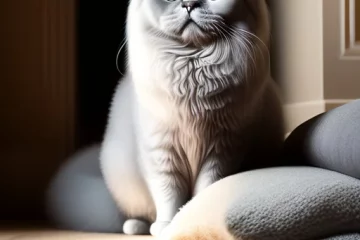Lilac Persian cats, with their captivating charm and exquisite beauty, are a unique and sought-after breed in the feline world.
These graceful creatures are known for their striking lilac coat color, which sets them apart from other Persians.
In this article, we will explore the fascinating world of lilac Persian cats, from their history and physical characteristics to their temperament and care requirements.

1. History of Lilac Persian Cats
The origin of lilac Persian cats can be traced back to the selective breeding programs that aimed to produce unique coat colors within the Persian breed.
Lilac Persians are a result of crossing blue and chocolate Persians, which led to the emergence of the dilute lilac hue.
This color variation was officially recognized by cat associations in the early 20th century. Thus, solidifying the presence of lilac Persians in the feline community.
2. Physical Characteristics
Lilac Persians are renowned for their striking appearance.
They have medium to large-sized bodies with a sturdy build and round faces.
Their most distinctive feature is their mesmerizing lilac coat, which showcases a soft and subtle shade of lavender-gray.
The fur is long, dense, and silky, requiring regular grooming to maintain its lustrous beauty.
These felines also possess large round eyes, typically in shades of copper or blue, adding to their irresistible allure.
3. Personality and Temperament
Lilac Persians have a gentle and affectionate nature, making them wonderful companions for both individuals and families.
They are known for their calm demeanor and their ability to adapt well to various living environments.
These cats appreciate a peaceful and tranquil atmosphere and may not be as active or energetic as some other breeds.
Lilac Persians thrive on human companionship and enjoy spending quality time with their owners.
4. Grooming and Care
Due to their long and luxurious coat, lilac Persians require regular grooming to keep their fur in prime condition.
Daily brushing is necessary to prevent matting and tangling, and occasional bathing helps to maintain cleanliness.
Their eyes and ears should be checked regularly and kept clean to prevent any potential issues.
Additionally, dental care and nail trimming should be part of their grooming routine.
5. Health Considerations
As with any breed, lilac Persian cats may be prone to certain health conditions.
These can include polycystic kidney disease (PKD), hypertrophic cardiomyopathy (HCM), and respiratory issues due to their flat faces.
Regular veterinary check-ups, a balanced diet, and a healthy lifestyle are crucial for their overall well-being.
It is recommended to obtain a lilac Persian kitten from a reputable breeder who conducts proper health screenings.
You May Also Like: Tortoiseshell Persian Cats: A Beautiful and Unique Feline Breed
6. Training and Socialization
Lilac Persians are intelligent cats that can be trained with patience and positive reinforcement techniques.
Early socialization is essential to ensure they grow into well-rounded and confident individuals.
Exposing them to various people, environments, and experiences from a young age will help them develop into friendly and sociable companions.
Interactive playtime and mental stimulation are also vital for their overall happiness and mental well-being.

You May Also Like: Training Your Persian Cat: Best Tips And Tricks
7. Lilac Persians as Pets
Lilac Persians make delightful pets for those seeking a loving and serene feline companion.
Their calm and gentle nature makes them ideal for individuals or families looking for a laid-back cat that enjoys a peaceful environment.
Due to their long fur, potential owners should be prepared for regular grooming sessions.
These cats thrive in indoor environments where they can enjoy a safe and secure space.
8. Finding a Lilac Persian Cat
If you are interested in adding a lilac Persian cat to your family, it is crucial to find a reputable breeder.
Look for breeders who prioritize the health and well-being of their cats, conduct proper genetic testing, and provide a nurturing environment for their kittens.
You can also consider reaching out to Persian cat clubs or rescue organizations that may have lilac Persians available for adoption.
You May Also Like: Interesting Ginger Persian Cats Facts
Conclusion
Lilac Persian cats are a captivating breed with their unique lilac coat color and endearing personalities.
They bring joy and tranquility to any home they inhabit, offering their owners unwavering companionship and affection.
With proper care, grooming, and attention to their health, these delightful felines can thrive and provide years of happiness to those fortunate enough to share their lives with them.
FAQs
Q1. Are lilac Persian cats hypoallergenic?
No, lilac Persians are not hypoallergenic. Like other cats, they produce allergens that can cause allergic reactions in sensitive individuals.
Q2. How often should I groom my lilac Persian cat?
Lilac Persians require daily grooming sessions to prevent matting and keep their coat in optimal condition.
Q3. Can lilac Persians live in apartments?
Yes, lilac Persians are well-suited for apartment living as long as they have sufficient space to move around and play.
Q4. Do lilac Persians get along well with other pets?
Lilac Persians can coexist peacefully with other pets, but proper introductions and gradual socialization are essential.
Q5. What is the average lifespan of a lilac Persian cat?
With proper care, lilac Persians can live between 12 to 15 years on average.


